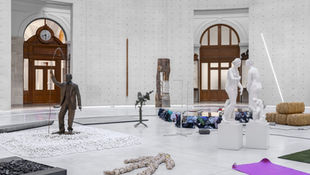
GOSHKA MACUGA
Goshka Macuga embraced a distinctive artistic strategy in which she moves beyond the traditionally perceived role of an artist in spite of using traditional media, such as sculpture, photography and film. Archival research informs her installations, which engage with the historical and social contexts of the host institutions: each project begins with a period of profound research in their collections and archives. The artist aspires to create new meanings and regularly offers viewers an opportunity to re-interpret facts and artefacts. By doing so she enters fields like philosophy, psychology, art history and esoteric science.

After graduation from Central Saint Martins (BA) and Goldsmiths College (MA) in London, she embarked on a professional career with her her first solo exhibition titled “Cave” that took place in 1999 in London. She curated pieces by her artist friends in a grotto-like space. The installation as a whole constituted a bitter reflection on the nature of works of art and the fashion of their presentation. Soon she had expanded the use of artworks by contemporaries in her installations to include those borrowed from institutions. The use of other artists in Macuga's activities takes on other forms. During her exhibition in Kate MacGarry's Gallery in London in 2005, the artist presented five monographs of famous artists like Picabia, Duchamp, Warhol, Polke and Kippenberger that she covered with a binding of her own design. Each one was based on the artist's subjective discretion. Her appropriation-based intervention posed questions about information flow, ownership, the possibility of using the information, as well as about the freedom of interpretation when taking advantage of available sources.
Macuga often uses art history as a point of reference. When she is working in a given institution, she starts by looking through its archives. When examining the archives of the London Tate, she created the exhibition, Objects in Relation (2007). The archive materials exhibited related mainly to the early-modernist British group, Unit One, which combined progressive ideas with a return to the world of nature. She placed these documents next to natural forms she had looked for in the natural archives of English forests. She searched for the monsters inside. At the Tate exhibition, following her nomination for the Turner prize in 2008, Macuga referred to the story of two artist couples active in Europe during the 1930s: Paul Nash and Eileen Agar as well as Mies van der Rohe and Lilly Reich.

The artist’s first individual exhibition in her native Poland did not take place until 2011. Untitled filled the space of the Zacheta National Gallery with documentation on the country’s legacy of censorship. Macuga used archival materials to show how the relationship between art and audience as well as the museum space itself has changed. It focused on mechanisms of the limitations it has placed, and continues to place, on the artist's freedom and the channels of communication. Examining certain situations over the past twenty years of exhibiting in Poland's major art institutions, Macuga illustrates how the fall of the former totalitarian regime did not immediately entail the fall of censorship, showing how the works of artists like Uklanski or Cattelan were demolished and how curators and works of art were targeted by both the government and the public itself.

In 2015, Goshka Macuga's solo show entitled “To the Son of Man Who Ate the Scroll” opened at the Fondazione Prada in Milan. The exhibition revolved around the concept of combining the role of an artist, curator, collector, researcher and designer, which is typical for Macuga. In accordance with the idea of pluralism and variegation, the exhibition area also included a mixture of visual arts – installations, sculptures, artefacts, photographs, and even performances and robots. She researched issues connected with time, the beginning and the end, as well as death and the act of rebirth. Apart from the seventy three oversized bronze heads, the most interesting element of the exhibition was an android, modelled after of the artist's partner at the time. Furthermore, visitors could listen to an Italian artist reciting fragments of Darwin's theory of evolution in Esperanto.
Macuga's work method is often described as cultural archaeology as she continues to develop her interest in the extensive connections within cultural history, especially that of the international avant-garde. Despite the technological advances, history is never simply a matter of onwards and upwards, in Macuga’s reality it moves in waves. She always succeeds in making concepts relevant and insists that she is not loyal to any medium, but rather to a rigorous methodology of investigation.





